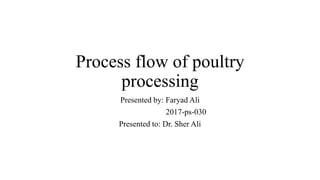
Process flow of poultry processing
- 1. Process flow of poultry processing Presented by: Faryad Ali 2017-ps-030 Presented to: Dr. Sher Ali
- 2. Contents Receiving Slaughtering • Stunning and killing • Scalding • De-feathering • Removal of head and legs • Evisceration and inspection chilling
- 3. Receiving • The birds are removed from the cages and transferred to continuously moving shackles where they are suspended by both legs. The transfer is often done in a dark room illuminated by a red light. • The birds are not sensitive to the red light and this helps to keep them calm.
- 4. Slaughtering • Slaughtering refer to killing of domestic livestock. The slaughtering involves some initial cutting, opening the major body cavities to remove the entrails. • Slaughtering is done by two methods; Traditional method Modern method
- 5. Traditional methods • HALAL: • The Islamic form of slaughtering poultry, involves killing through a cut to the jugular vein, carotid artery and windpipe. • Muslim method of slaughtering. • No blood should be left in carcass. • JHATKA- • Practiced by Sikhs. • Head is completely removed in one stroke.
- 6. Cont… Kosher: • A Jewish method, Only sheep, goat, deer, cattle and poultry slaughtered. • Meat should not contain any blood vessel • Meat should not be preserved for more than 3 days.
- 7. Stunning and killing • After the birds have been transferred to the moving shackles, they are usually stunned by running their heads through a water bath that conducts an electric current. • It is also done by giving carbon dioxide. • Stunning produces unconsciousness, but it does not kill the birds. • The birds are killed either by hand or by a mechanical rotary knife that cuts the jugular veins and the carotid arteries at the neck. • The birds are permitted to bleed for a fixed amount of time, depending on size and species (e.g., 1 1/2 minutes for broilers).
- 8. Cont… • The birds are permitted to bleed for a fixed amount of time, depending on size and species (e.g., 1½ minutes for broilers).
- 9. Scalding • Scalding Following bleeding, the birds go through scalding tanks. These tanks contain hot water that soften the skin so that the feathers can be removed. • The temperature of the water is 50-55 °C for 1-3min. • Turkeys & spent hens ( egg-laying birds that have finished their laying cycles) are generally run at higher temperature- 59 to 60°C for hard scalding.
- 10. Defeathering • The carcasses then go through the feather-picking machines, which are equipped with rubber fingers. • An extra process, called wax dipping, is often used for waterfowl, since their feathers are more difficult to remove. • Following the mechanical feather picking, the carcasses are dipped in a melted, dark-coloured wax. • The wax is allowed to harden and then is peeled away, pulling out the feathers at the same time. The wax is reheated and the feathers are filtered out so that the wax can be reused. This process is usually performed twice
- 12. Removal of head and legs • The heads of the birds go into a channel where they are pulled off mechanically, the legs of the birds are removed with a rotary knife (much like a meat slicer).The carcasses drop off the shackle and are rehung by their hock onto the eviscerating shackle line.
- 13. Cont… • By law in the United States, the scalding and defeathering steps must be separated by a wall from the evisceration steps in order to minimize cross-contamination
- 14. Evisceration and inspection • At this point the preen, or oil, gland is removed from the tail and the vent is opened so that the viscera (internal organs) can be removed. • Evisceration can be done either by hand (with knives) or by using complex, fully automated mechanical devices. Automated evisceration lines can operate at a rate of about 70 birds per minute. The equipment is cleaned (with relatively high levels of chlorine) after each bird. • The inspection procedures in the poultry industry vary around the world and may be performed by government inspectors, veterinarians, or plant personnel, depending on a country’s laws.
- 17. Chilling • After the carcasses have been washed, they are chilled to a temperature below 4 °C (40 °F). The two main methods for chilling poultry are water chilling and air chilling.
- 18. Water chilling • In which a countercurrent flow of cold water is used to lower the temperature of the carcasses. • it is common to employ long chillers (e.g., 10- 50 m long) that use a counter flow of cold water, sometimes supplemented with crushed ice, to bring carcass temperatures to about 4 - 5°C within 30 - 75 min. • The carcasses are then moved into a chiller • Two tanks are used to minimize cross-contamination.
- 19. Cont… • Water chilling leads to an increase in poultry weight. In the United States the legal limits for water pickup are 8 percent for birds going directly to market and 12 percent for birds that will be further processed.
- 20. Air chilling • The carcasses are hung by shackles and moved through coolers with rapidly moving air. The process is less energy-efficient than water chilling, and the birds lose weight because of dehydration. • Air chilling prevents cross-contamination between birds. However, if a single bird contains a high number of pathogens, this pathogen count will remain on the bird. Thus, water chilling may actually result in a lower overall bacterial load, because many of the pathogens are discarded in the water.